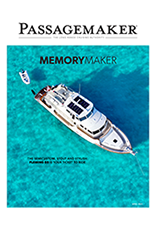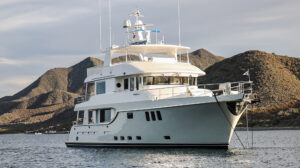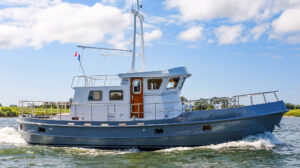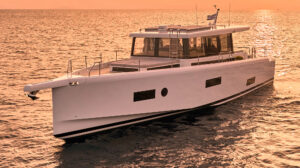
Here’s a useful tip: you can learn a great deal about a cruising yacht by seeing how she rides on the hook. Spending a day or, even better, a night at anchor can reveal many things that are linked directly to her qualities of seaworthiness. It’s not a usual ingredient of most sea trials, but it can be illuminating.
For example, some yachts hunt around constantly while anchored, roving from one end of the anchor scope to the other even in light airs, and it’s been my experience that these are boats that aren’t happy at sea. They can be skittish in a blow or wanderers in a following sea, and they all seem to lack directional stability.
Offshore Yachts builds a series of 58- to 62- footers on the same basic hull, and, from personal experience, I can tell you that they feel like they were planted in wet concrete when anchored. Strong winds or light winds, cross seas and in current, they have impeccable manners.
And those manners translate directly to the seakeeping qualities of the Offshore 62. On most boat tests, I would tell you about the layout or the quality of the joinerwork or the comfy sofas first, but not with the Offshore 62. Although she has world-class interiors, her forte is out there where the sea stretches endlessly to the horizon. You can find great joinerwork and wonderful fabrics on a lot of yachts, but if they aren’t good at sea, well, you might as well buy a waterfront condo.
This particular Offshore 62 is hull number 96, which may not seem like many if you’re thinking cars from Detroit, but there are more than a few boatbuilders who’ve never seen that many boats. The reasons for the 62’s success are multiple: great seaworthiness, superbly finished interiors, and rugged construction with an eye toward detail. What more could you want?
Offshore Yachts is no Johnny-come-lately to the boatbuilding world. By the time that 1960s businessman took a young Dustin Hoffman aside in The Graduate to offer the advice: “I just want to say one word to you-just one word: plastics,” Offshore Yachts founder Richard Hunt had already been pioneering the remarkable properties of plastic, or, more properly, fiberglassreinforced plastic (FRP), for more than two decades.
Hunt worked with the U.S. Navy duringWWII to develop this newfangled material, and when the smoke of war had cleared, he started building some of the earliest laminated fiberglass pleasure boats. His two sons joined the business in the ’50s, and the late naval architect Bill Crealock began a long and productive collaboration with the Hunts and Offshore in the ’60s, penning yachts with handsome lines that remain ageless.
One reason for the success of the Offshore 62, with an LOA that can be anywhere from 58 to 62 feet, depending on cockpit size, is that seakindly Crealock hull. With a deep forefoot, a mild deadrise, and substantial displacement, these yachts are easy in a seaway. And, with long keels and a low center of gravity, they were designed with offshore voyaging in mind.
A second factor is Offshore’s attention to detail. Unlike some builders, who throw a successful baby out with the model-change bathwater in the quest for something new, the powers at Offshore Yachts instead choose to perfect the breed. That’s one reason Offshore Yachts enjoys a remarkable number of repeat owners- many of whom are on their third or fourth Offshore.
Keep in mind that Offshore Yachts is a semi-custom builder, so each yacht is tailored to the needs and wants of the owner. There are, of course, some standard arrangements, as well as some bulkheads that can’t be moved. But, hey-if you want an empty saloon for ballroom dancing, so be it.
COMFORT AND STYLE
Our test 62 had an interior by Kristi and Jeannie Murray of Wright Yacht Interiors in Costa Mesa, California. They may not be well-recognized names now, but stick around: they have a fun and cheerful touch.
As you’d expect, the cockpit on the 62 is immense, and it hasn’t been divvied up with built-in settees or tables. It’s simply an expanse of beautiful teak with centerline double doors to the swim platform, ready for diving, fishing, or loafing.
Double teak sliders open to the saloon, boasting a large settee around a high-low cocktail table that unfolds for dining. A pair of hassocks adds length for stretching out on the settee to watch the pop-up TV in a cabinet to starboard. Two loose chairs add to the seating for meals, and the settee can convert to a double berth if needed. Teak is the standard choice for the extensive joinerwork and built-in cabinets with raised panels, all of which are examples of a master woodworker’s touch.
Just forward, the galley is open to the saloon and, above the cabinets, to the raised pilothouse.With granite counters, the galley has all the expected amenities, from Sub-Zero drawer fridges to a Princess oven and Broan trash compactor. There is stowage galore in drawers, lockers, and above- and below-counter cabinets. Offshore gets a gold star for providing solid sea rails on all counters so that no spilled soup or coffee will dribble down the gorgeous teak.
One impressive feature of the saloon-galley area is the airiness, due to oversized windows that provide a great view even while seated. And, with the side decks shaded by the overhanging boat deck, the saloon is protected from the midday sun in tropical climates.
The raised pilothouse is everything you’d expect from a yacht designed by and for experienced offshore skippers. The ergonomic shape of the dashboard wraps around from a chart table, past the three Nauticomp monitors and the teak-rimmed wheel, to a console at the skipper’s right elbow that’s thoughtfully provided to hold everything from binocs to a chart guide to a mug of tea. Two Pompanette helm chairs sit forward of an L-shaped settee that can convert to a pilot berth offshore. Finishing off the pilothouse is a cabinet to starboard with a Sub-Zero freezer/ice maker.
Skippers will also appreciate the great visibility in the pilothouse, which, because the saloon is not closed off, includes both aft corners of the yacht for easier docking. Two teak-faced doors to the side decks not only secure with dogs but also suck in on gaskets for watertight integrity.
If you tour the 62, you must stop to examine the electrical panels for DC and AC power that are on the outboard side of the helm console. Don’t just admire the neatly labeled breakers and switches; pop the latches and hinge the fascia out. Behind it, you’ll see a textbook example of thoughtful and seamanlike wiring practices, with carefully loomed main cables and ease of access for chasing problems.
LOTS TO LOVE
Down the steps are the staterooms, and it’s in this area that most owners are likely to start doodling their own layouts. The Offshore 62 I toured had a fairly conventional three-cabin, two-head arrangement. Forward, the VIP stateroom offers a centerline double berth (V-berths are an option), two realistically sized hanging lockers, and direct access to a spacious head with shower.
Opposite is what home builders might call a “bonus room.” On our test boat, this guest cabin was fitted with stacked bunk beds, which left room for a hanging locker and seat, since the pocket door saved space. This cabin also can be finished as an office, with a computer desk and Pullman-style single berth.
Just aft of the foyer is the master stateroom, which takes advantage of the nearly 17-foot beam for a getaway lined in satiny teak. The athwartship berth is set into a padded headboard between two built-in nightstands, and the forward bulkhead has a 15-drawer (!) bureau with a granite countertop.While some owners choose to devote the aft bulkhead to hanging lockers, this 62 had built-in bureaus interspersed with lockers, giving her a total of 27 drawers in the master. The master head, equipped with a large shower, runs along the starboard side with, need I say, more drawers for toiletries and lockers for towels.
Up on the flybridge, the helm area is protected by a beautifully finished fiberglass hard top, complete with planking on the underside. Like the rest of the Offshore 62, the boat deck aft has an aggressive nonskid surface. Another gold star: there is nonskid anywhere you might plant your Top-Siders, including the eyebrow above the pilothouse and on the hard top itself.
The fiberglass bridge console on our test 62 had a single electronics monitor plus the engine screens, a stainless steel destroyer wheel, and a settee that wraps around two tables for easy egress. Unlike some lowbacked settees, this one had a comfortably high back for support on long trips, and it was upholstered in a cheery tropical fabric. The two tables are a good example of Offshore Yachts’ thoughtfulness: full edge rails keep drinks and munchies in place, but each table corner has a tidy groove so rainwater or spray won’t puddle there. Slick.
Here’s another thoughtful touch: a watertight hatch in the companion seat footwell not only provides light and fresh air to the pilothouse but also offers an easy way to pass a tray of grilled cheese sandwiches and chips to the bridge.
Aft, the boat deck is surrounded by beautifully welded double stainless steel rails, and there is ample room for a 14-foot RIB tender or water toys, launched with a Brower 1,600-lb. crane.
Look closely and you’ll notice that the coaming surrounding the boat deck is pierced by several large freeing ports to quickly dump the water from a tropical downpour. Those ports are set above the level of the sole, because the primary drainage system for the bridge is through flush-mounted drains that direct normal amounts of rain or wash water through hidden pipes to the waterline. It’s a lot of work to engineer this system, but you’ll never have those telltale dirty stripes on the bridge or topsides from conventional drains.
MECHANICAL BLISS
Be still my foolish heart: the Offshore 62 has an engine room that will please-nay, delight-even the most hands-on owner. First, there’s plenty of room to move between the main engines on Treadmaster decking. Second, there’s sufficient headroom to protect those of us with thinning hair. Best of all, Offshore Yachts really understands the word “service.” Everything-from the fuel filters to the tank manifolding-is easy to reach, clearly labeled, and securely mounted. The engines are soft mounted to reduce vibration, and they’re on oversized stainless steel engine beds bolted to huge stringers.
Once again, the beauty is in the details. All of the fuel system plumbing is copper with multiple shutoff valves, the manifolding is stainless steel with full-flow valves, and bronze Groco seacocks are readily accessible. Notice that all the independent bulkhead compartments are made common with bronze gate valves, too. Bottom line: this is an engine room designed and built by someone who has actually worked in an engine room.
Our test boat was upgraded from the standard 700hp Caterpillar C12s to twin MAN 800s, but Offshore Yachts is comfortable installing engines of all colors. Generators are another owner choice; a 12 or 16kWNorthern Lights is a popular selection. Our test boat had TRAC digital stabilizers, as well as TRAC bow and stern thrusters, all running off PTOs (power take-offs) on the mains.
Under way, the Offshore 62 is everything you might want, and more. She’s fast (20-plus knots with the MANs), well mannered, and solid. The cockpit steering station is standard, and this is truly a “steering” station, rather than just engine and thruster controls: the starboard-side console has a stainless destroyer wheel and full engine/thruster controls, making this an easy yacht for shorthanded docking.
We had a chance to run her in the long Pacific rollers off Newport Beach, California, courtesy of John Olson at OffshoreWest, and I tried to get her to stumble by taking waves beam-on, running down sea at too slow a speed, and heading upwind too fast. She was dry, stable, and completely poised.
As one Offshore owner once said to me, “I know I’m young enough to own several more yachts in my lifetime, but I like my Offshore so much that I know it’s going to be my last!”
No question about it: the Offshore 62 is a keeper.
OFFSHORE 62
LOA 64′ 6″
LWL 56′
BEAM 16′ 10″
DRAFT 4′ 8″
DISPLACEMENT 70,000 lb. (dry)
BRIDGE CLEARANCE 17′ 6″
FUEL 1,000 U.S. gal.
WATER 400 U.S. gal.
HOLDING TANK 85 U.S. gal.
GENERATOR 12kW Northern Lights
ENGINES 800hp MAN diesels
MAXIMUM SPEED 20.1 knots
CRUISE SPEED 10.1/14.5 knots
RANGE AT CRUISE SPEED 842nm at 10.1 knots
DESIGNER William Crealock
BUILDER Offshore Yachts
BASE PRICE $1,642,340 For more information: Offshore Yachts www.offshoreyachts.net











